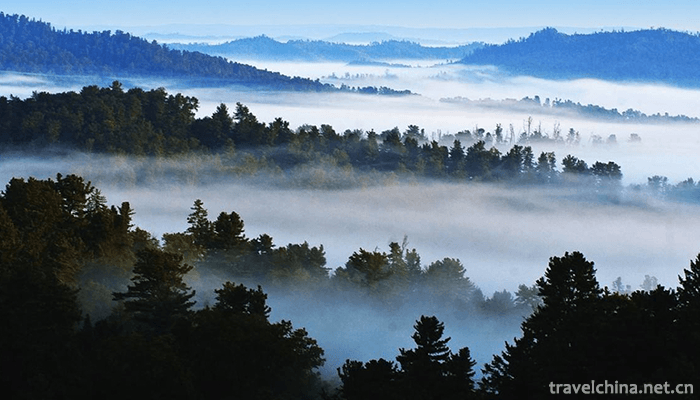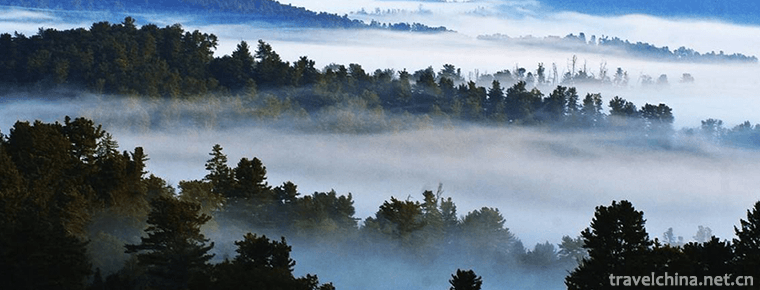Shangganling Xishui National Forest Park
Shangganling Xishui National Forest Park combines the strong local flavor and exotic style with the elegance of "paradise". It has both unique natural landscape and distinctive humanistic landscape. Every scene in the park will be pleasant and lingering. The scenery of Xishui National Forest Park is charming and magnificent. It is a good place for your leisure, vacation, tourism and sightseeing. It is also a highlight of Yichun's "eco-tourism" corridor.
geographical environment
Xishui National Forest Park has a unique geographical location. It is located in the middle section of Xiaoxing'an Mountains, Tangwang River Basin, with a total area of 4580 hectares. The park is located in Xishui Forest Management Center, bounded by Yiwu Highway in the northwest. The New Spring Highway passes through the park from the north to the south. It divides the park into two triangles naturally. The traffic is very convenient. It is a good place for you to enjoy leisure, vacation, tourism and sightseeing. It is also a highlight of Yichun's "eco-tourism" green passage.
Ecotourism
Shangganling Xishui National Forest Park combines the strong local flavor and exotic style with the elegance of "paradise". It has both unique natural landscape and distinctive humanistic landscape. Every scene in the park will be pleasant and lingering. The scenery of Xishui National Forest Park is charming and magnificent. It is a good place for your leisure, vacation, tourism and sightseeing. It is also a highlight of Yichun's "eco-tourism" corridor. The unique natural and cultural landscape of Shangganling River Park, with its exotic elegance, combines the strong local flavor and exotic sentiment. Visit mushroom pavilion, mountain peak pavilion, general pavilion, evergreen pavilion, sentry tree, hunter's house, windfallen tree, monkey head tree, badger hole, Panshan Road, suspension bridge, mountain springs and streams under bridge, clear to the bottom, Russian Custom Park. It covers an area of 20 hectares, including the National Customs Leisure and Entertainment Center and the Customs Performance Park. The garden is based on Russian style architecture. Visiting here can not only appreciate exotic customs, appreciate Russian colorful national dances, listen to Russian elegant classical music, but also buy exotic Russian goods and taste five Russian meals. When night falls, the bonfire reflects the red sky, dancing with Russian girls and feeling exotic.
natural resources
Primitive arbor ornamental garden. It
covers an area of 476 hectares and has more than 1390 species of primitive
plants. Primitive arbor ornamental garden is mainly composed of primitive
coniferous and broad-leaved mixed forests. There are not only primitive Korean
pine forests, but also more than 20 tall trees, including all the precious tree
species of tall trees in Xiao Xing'an Mountains. Biological diversity is
vividly reflected here, which not only has ornamental value, but also has the
feasibility of biological examination and research.
Main attractions
According to the natural advantages, the
park is planned as "seven districts, six sceneries and two gardens".
Seven districts: animal protection area, plant cultivation area, wetland bird
protection area, Artificial Korean pine mother forest protection area, hunting
area, primitive arbor viewing area, leisure and entertainment area. Six
Sceneries: Anti-Japanese Union Site "old money cabinet", national
standardized nursery, Diaoyu Island, sightseeing tower, Luyuan, Songtao
Pavilion. Two gardens: Russian Style Park and Water Paradise.
Development and construction
Shangganling Xishui National Forest Park under development and construction has elegant environment and unique natural landscape (5 pieces)
It's the best choice for tourism vacation. It's a place to play. It can stay away from the crowded city, breathe fresh air, appreciate the beautiful scenery of nature, appreciate the unique garden art and folk culture, appreciate Russian songs and dances, and feel the simple feelings of Ganling people.


-
1.The Mutianyu Great Wall
The Mutianyu Great Wall in Beijing is located in Huairou District of Beijing, 73 kilometers from the urban area of Beijing. With a long history and splendid culture
Time 2018-11-24 -
2.Zhengzhou Xiao Ji stewed noodles
Zhengzhou Xiao Ji stewed noodles,Xiao Honghe, the founder of Xiao Ji Yanmian, was a master of Yifumian at Changchun State-owned Hotel in Zhengzhou.
Time 2018-11-26 -
3.Nine Towers Chinese Folk Happy Garden
Jiudingta Chinese Folk Happy Garden is a large-scale original ecological and cultural tourist area which integrates Chinese national customs, scenic spots, waterfalls, recreational exploration
Time 2018-12-22 -
4.Yunwushan Scenic Area
Yunwushan Scenic Spot is located in Paulownia Shop in the northwest of Huangpi District. It enjoys the reputation of "Xiling Resort Area, North Chu Famous Area, Beixi Border Barrier and Handizush
Time 2018-12-22 -
5.Zhongshan Park
Zhongshan Park is located in the south of the Forbidden City (Palace Museum) in the center of Beijing, west of Tian'anmen, and separated from the Palace Museum.
Time 2018-12-22 -
6.Daishan Lake
Daishan Lake is located in the ancient town of Feidong County, Hefei City, Anhui Province. Daishan Lake has a subtropical climate, warm and humid, with an average annual temperature of 15.7 degrees Ce
Time 2019-01-08 -
7.Bogda Ula Festival
The sacrifice of Bogdahura (Shenshan) is one of the earliest forms of Mongolian creative culture in China. It is the product of national culture, which is formed by historical accumulation and plurali
Time 2019-04-04 -
8.Gourd sculpture
There are two techniques for carving gourds. One is to use three kinds of special steel needles, large, medium and small, to carve the landscape, flowers and characters in the gourd
Time 2019-05-03 -
9.Wood Watermarking Techniques
Wooden watermarking is mainly made by such basic technological procedures as hook (sub-plate), engraving (plate-making), printing (printing) and special techniques as engraving, picking and dusting.
Time 2019-06-06 -
10.Qing Opera of Wa Nationality
The Wa Qing Opera belongs to the high-pitched system, with different roles for men and women. The roles are similar to those of Sheng, Dan, Jing and Wei. Use a dye called "Red Drug" to colou
Time 2019-06-25 -
11.Zhuxian Town Wood Print New Year Picture
Zhuxianzhen Wood Engraving New Year Picture is one of the ancient Chinese traditional crafts. As the originator of Chinese woodcut New Year pictures, is mainly distributed in Kaifeng, Zhuxian Town and
Time 2019-08-10 -
12.Firing Techniques of Zibo Ceramics
During the Wei, Jin, Southern and Northern Dynasties, Zibo began to produce porcelain. During the Tang and Song Dynasties, the technology of making porcelain was constantly improving. During the Ming
Time 2019-08-16